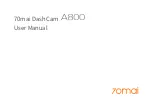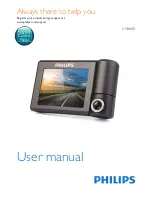
Copyright 2010 International Safety Instruments, Inc.
4
!
IMPORTANT POINTS
Please read all carefully
The ISI 2500 and ISI 3500 Thermal Imaging System is
not life support equipment and should not be used
as such. Failure to properly maintain and operate this
product could result in its’ failure, leading to possible
injury and/or death.
INTENT
This manual is intended to acquaint owners’ and users’
with the operation of the ISI 2500 and ISI 3500 Thermal
Imaging Systems and to provide important safety
information and limitations. All information, illustrations
and specifications in this manual are based on the latest
product information available at the time of printing. The
right is reserved to make changes at any time without
notice.
IMPORTANT
All personnel using this product shall be
thoroughly familiar with the operation,
inspection and safety precautions outlined in
this manual.
Equipment should be thoroughly checked
and cleaned after exposure to intense heat or
harsh chemicals.
The ISI 2500 and 3500 is designed to be simple to
use and easy to maintain and will operate for many
years if properly handled, maintained and cleaned. The
instructions for care and use given in this manual must
be read, understood and carefully followed before the
equipment is used.
The procedures in this manual DO NOT render ISI liable
for any losses or injury arising from actions based on use
of same.
Spare parts and accessories are available through
your local ISI authorized distributor. Service beyond the
scope of this manual is not recommended. If a problem
arises, the equipment should be removed from service,
tagged for repair and forwarded to the ISI factory or an
ISI Camera Certified Service Center for evaluation and/
or repair.
DESCRIPTION
The ISI 2500 and ISI 3500 Thermal Imaging System is
designed to provide the trained user with the ability to
see in dark and smoke filled environments. Engineered
to withstand the rigors of firefighting, the ISI 2500 and
3500 can be used for search and rescue, size-up, seat
of fire location, HazMat, and overhaul operations. Once
integrated into the Standard Operating Procedures, the
ISI 2500 and 3500 will become one of the most important
firefighting tools used to save lives and property.
OPERATOR INFORMATION, WARNINGS, LIMITATIONS
& TRAINING REQUIREMENTS
All operators must read, understand and be thoroughly
familiar with the operation and use of the equipment and
the contents of this operators manual prior to first use.
WARNING: NEVER point the thermal imaging
camera directly at
the sun.
WARNING: Improper use or abuse of this
equipment in a hazardous environment or
atmosphere could result in serious injury or
even death.
As with all fire service equipment, standard operating
procedures must be written, implemented and
followed for the thermal imaging systems. Priority
should be given to proper egress should the
equipment malfunction or fail while inside the fire
scene.
All operators and potential operators should receive
training in a controlled fire scene simulation (i.e. training
tower or live burn) before actual use in a fire environment.
Training shall include egress procedures should the
camera system fail.
Thermal Imaging Cameras and their accessories are not
life support equipment and shall not be used as such.
The service life or battery duration of this camera can
be reduced by heavy usage or extreme environmental
conditions. Every fire scene and environment is unique
and therefore battery duration can not be predetermined
to an exact time limit. The operator is required to
IMMEDIATELY egress from the hazardous environment
when the yellow LED goes out leaving the red LED as
the only LED lit. Users’ should only enter a hazardous
environment with a fully charged battery. The fire
environment affects the duration of the battery and
therefore exact duration time will vary from incident to
incident. Exposure to extreme high heat environments
for an extended period of time and repeated exposures
to high heat environments may result in the degradation
of the thermal image and possible damage to the camera
sensor. Allow for adequate cool down when exposed to
extreme high heat before reusing the camera. The user
shall adhere to the “Sensor Temperature Warning” section
(3.7) of this manual.
The thermal imaging camera is not capable of seeing
through glass, water or reflective objects. Although IP67
waterproof, the camera cannot be used underwater.
The
ISI 2500 and ISI 3500 is not rated as “intrinsically
safe.”
Use extreme caution and avoid explosive
atmospheres when operating this camera. Radio
transmissions and other electromagnetic radiation may
cause interference with the ISI 2500 and 3500.
PREFACE
!
!
!





























